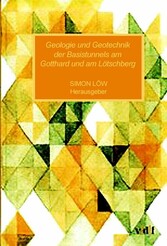Suchen und Finden
Mehr zum Inhalt

Geologie und Geotechnik der Basistunnels am Gotthard und am Lötschberg (DOI-Nr. 10.3218/3158-4)
Geologisch-geotechnische und hydrogeologische Verhältnisse im Vortrieb Amsteg: Vergleich zwischen Prognose und Befund (S. 101-102)
B. Frei &, T. Breitenmoser
Dr. M. Kobel &, Partner AG, Ingenieurgemeinschaft Gotthard-Basistunnel Nord, Amsteg, Schweiz ABSTRACT: In the Amsteg-part of the Gotthard Base-tunnel, the excavation of the two tunnel tubes started in the middle of 2003. The tubes are excavated by tunnel drilling machines of the Herrenknecht Company. In the east-tube, three-quarters of the 11.35 km long subsection, in the west-tube two thirds, have already been excavated. The following paper focuses on the geological, geotechnical and hydrogeological behaviour of different lithologies. Especially, its influence on the rate of progress of the TBM and on the civil engineering conditions is pointed out. It’s intended to show how prediction and reality correspond and where the main deviations with respect to the progress of construction work result.
The rock mass to be driven through consists entirely of crystalline rocks, which show different metamorphic overprints. The following discussion describes the geotechnical problems associated with the traversed geological units.
In the „altcristalline" units the encountered geology appeared mostly as predicted. The tunnel encountered partly migmatized biotite-gneisses which showed minimal overprint of the alpine metamorphism. Apart from these biotite-gniesses chlorite-sericite-gneisses which showed a stronger alpine overprint were tunnelled through. In between were recognized zones of Amphibolitschollen. In the sheared chlorite-sericite-gneisses overbreaks were infrequent, while in the more massive biotite-gneisses stress-induced overbreaks were often observed. From the geotechnical point of view the highest progress rates were achieved in sheared parts of the altcristalline rocks.
Encountering the Bristner Granite at Tm 108’362 in the eastern tube respectively km 208’379 in the western tube was a surprise, since on the surface no outcrops have been observed. At the tunnel level the granite was encountered over a length of more than 600 m. The Bristner Granite shows a weak alpine overprint and is supposed to be a late variscan intrusive body like the Aar Granite. Rock-burst-like phenomena occurred near the tunnel face and considerable spalling in the rear of the TBM backup system required additional supportive measures and led to decreased progress rates. The Aar Granite shows a more gneissic structure compared to the Bristner Granite. As expected, when joints were more widely spaced with a high degree of intersection overbreaks consisting of large blocks often occurred. In the Northern Aar Granite a major block of about 10 m3 formed by the intersection of unfavourable joints crashed down from the left vault 35 m behind the face. The occurrence of block falls is often associated with unfavourable stress rearrangements.
The Intschi-Zone was encountered further south than expected because of shallower dipping foliation than predicted. Apart from this, the zone was traversed for a length of 444 m instead of the predicted 950 m. Over the first 100 m of the zone the pyroclastic rocks had a schistous to phyllitic structure. In this section, squeezing ground behaviour was observed. After crossing this zone comact, pyroclastic rocks occurred. This was in accordance to the predicting gneissic phyllitic rocks for the most part of the Intschi-Zone and phyllitic rocks only in minor parts. Some thin, graphitic layers were encountered at the beginning of the Intschi-Zone and in a far less amount than expected.
Alle Preise verstehen sich inklusive der gesetzlichen MwSt.







